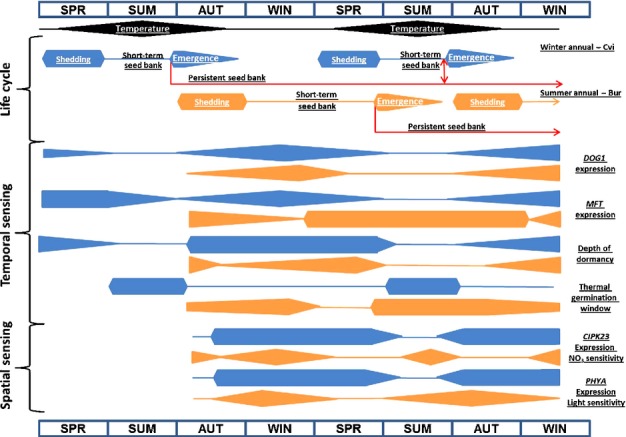Figure 7.

Seed responses (molecular and physiological) to environmental sensing (temporal and spatial) drive progress through the annual dormancy cycle to time the key lifecycle transition from seed to seedling (germination) in Arabidopsis. The schematic summarises data from the present study, Footitt et al. (2011, 2011) and illustrates how subtle differences in the coordination of these responses can result in winter and summer annual lifecycles of Arabidopsis ecotypes. These studies have also shown how hormone metabolism and signalling networks operate to put into effect these responses to the soil environment. In the schematic the winter annual ecotype Cvi is represented by the blue bars and the summer annual ecotype Bur by the orange bars. The height of each bar indicates the amplitude of the response measured across the seasons. Temperature represents the annual fluctuation in soil temperature at seed depth. Seed shedding times and emergence timing are based on the field observations. The short-term seed bank is made up of those seeds that are shed from the mother plant, enter the soil, lose dormancy and germinate in the soil in one dormancy cycle so contributing to the next sequential generation. The persistent seed bank represents seeds that pass through more than one annual dormancy cycle thus dispersing seeds in time. Temporal sensing shows the major changes in molecular (DOG1 & MFT) and physiological markers for dormancy. Depth of dormancy is related to the time to 50% after-ripening (AR50; Cvi) and Ψb (base water potential; Bur) in seeds. The thermal germination window represents that period when as a result of declining thermodormancy the thermal base line for germination and soil temperature overlap, so permitting germination and seedling emergence if other environmental requirements are met (water, light, nitrate). Spatial sensing shows when seeds exhibit increased germination potential as reflected by sensitivity to environmental signals such as light (PHYA) and nitrate (CIPK23), which inform the seed as to its position in relation to the soil surface and existing vegetation.
